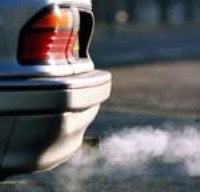Car makers to make cars less polluting
Automakers are facing a number of choices and technologies, from ion-lithium batteries coupled with diesel engines to hydrogen and natural gas to reduce pollution.

Manufacturers and analysts say the more choices there are to make cars less polluting the better, because ultimately it means consumers and the environment will benefit.
"You would think they would like a standardization of powertrain globally," said Jack Nerad, executive market analyst for Kelley Blue Book in Irvine, California. But until they have that, "everybody's looking for that competitive advantage and nobody wants to be on the wrong side of the green movement."
Hybrids have taken the public's fancy in the U.S., led in part by Toyota Motor Corp.'s Prius, which has become the poster car for cleaner emissions.
In Europe, though, hybrids have been slower to catch on in part because automakers have long embraced the use of diesel, which burns cleaner and emits fewer pollutants than unleaded gasoline.
It's a split likely to continue given the research being done by Volkswagen AG and DaimlerChrysler AG, among others, into the use of diesel to make engines more efficient and reduce emissions.
Olivier Rabiller, vice president for customer management at Honeywell Turbo Technologies' passenger vehicles unit, said his company has been working with Volkswagen to improve diesel engines and their performance.
Consumers in Europe have grown used to the fact that buying a diesel-powered car means lower emissions because it also provides more torque and, thus, more power, especially when the engines are turbodiesels.
"We are used to seeing the Germans really pushing in that direction, but not (just them) any longer," he told The Associated Press. "Others have announced they would use diesel to help save fuel, too. It is a very strong message to the industry."
Dozens of cars - both production and concept - were unveiled at the Frankfurt auto show with new forms of propulsion that are environmental in nature.
Volkswagen had five models, along with a version of its mainstay Golf, that used refinements it called BlueMotion to reduce emissions to 119 grams per kilometer (4.2 ounces for just slightly more than every half mile) from 135 grams (4.7 ounces).
Erich Merkle, vice president of forecasting for consulting company IRN Inc. in Grand Rapids, Michigan, said U.S. buyers tend to favor hybrids because there's a premium on diesels in the United States.
"Hybrids are a global phenomenon. If Europe is going to maintain its competitive posture here in the States, they'vegot tohave a hybrid option," he said. "They are heavily dependent on the U.S. market. It would be really shortsighted to not pursue it."
They are. Porsche AG showed off a version of its Cayenne sport utility vehicle that is powered by hybrid technology developed with Volkswagen, and BMW pulled back the curtain on its X6, an SUV coupe crossover hybrid.
GM showed off its Flextreme from European subsidiary Opel, a small commuter car with an electric-diesel hybrid that can travel 55 kilometers, or 34 miles, on a single charge before switching to fuel. It is a concept car, meaning it may or may not go into production.
The Flextreme uses a battery to produce no emissions directly - and packs a small turbo-diesel engine for when the juice runs dry.
The options are plentiful, said GM Europe President Carl-Peter Forster, who said that consumers would see "a competition of various technologies and, ultimately, the one that best suits the needs" would win.
Sergio Marchionne, president of the European Automobile Manufacturers' Association and chief executive of Fiat SpA, said that automakers have invested extensively in carbon dioxide-cutting technologies in the past decade.
"The innovations cover a wide variety of areas, such as engines and transmission, alternative fuel technologies, lightweight materials and aerodynamics," he said.
European automakers said they support an EU plan to lower carbon dioxide emissions to 120 grams per kilometer, but that it would take a major effort to meet a 2012 deadline. The current average is around 162 grams per kilometer.
Pressure for a stricter limit came from the European Parliament's environment committee on Wednesday when it demanded the European Commission hold carmakers to the 120-gram target. They also called for a legally binding target of 95 grams by 2020. EU officials who draft laws do not have to heed the Parliament's vote.
Campaign group Transport and Environment said this sent a clear signal to the car industry and the European Commission that low-carbon cars are needed "right here, right now."
Analysts said the impetus in the drive for alternative power methods boils down to the fact that gasoline prices are high and keep rising.
"As petrol becomes more expensive, alternatives will become more affordable," said Charlie Vogelheim, vice president of automotive development at J.D. Power. "In its day, petrol was the clean alternative - think of the emissions from the steam engine and the horses that went before it. Now we need to find something else."
Subscribe to Pravda.Ru Telegram channel, Facebook, RSS!


